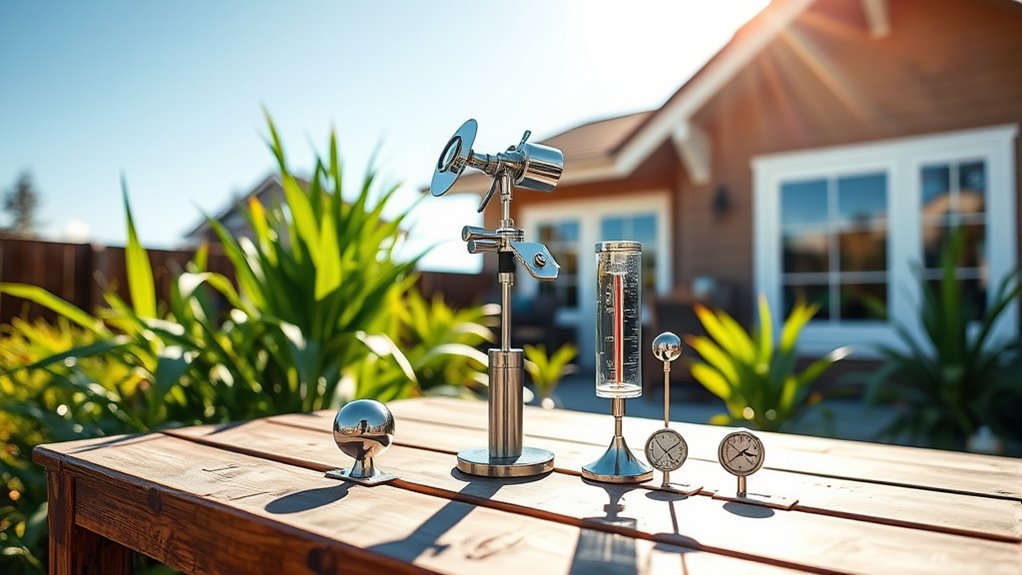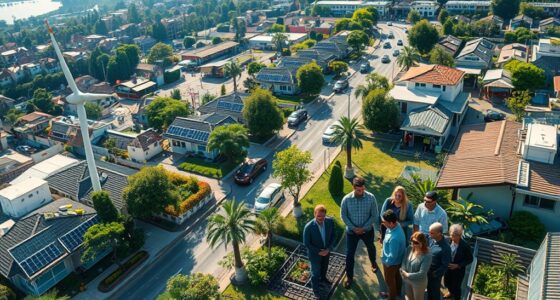To set up a home weather station, start by choosing the right equipment based on your data needs and budget. Pick an open area for installation, ideally away from structures that could interfere with readings. Mount your sensors according to the manufacturer's instructions and connect power sources. Once it's up, configure your device and regularly calibrate it for accuracy. There are plenty more tips you'll find to ensure optimal performance and reliable data collection.
Key Takeaways
- Choose a suitable location for your weather station, ideally 6 to 8 feet high and away from obstructions like trees and buildings.
- Follow the manufacturer's installation instructions carefully, ensuring all sensors are securely mounted and connected to a power source.
- Configure your base unit indoors within wireless range, and set up Wi-Fi for real-time data access and continuous logging.
- Regularly calibrate and maintain sensors by checking for damage, cleaning components, and ensuring secure attachments for accurate readings.
- Share your findings and engage with the community by integrating your data with platforms like Weather Underground for broader impact.
Choosing the Right Equipment

When you're selecting a home weather station, consider your specific needs and how much data you want to track. If you only need basic information, a basic station that measures temperature and humidity will suffice. Additionally, understanding weather patterns can help you choose a station that provides the most relevant data for your area. Regular maintenance of your equipment can improve its longevity and accuracy, ensuring you receive reliable readings from your appliances. High-quality sensors are essential for color accuracy in weather stations.
For those looking for more details, an intermediate station adds wind speed and rainfall data. If you're a weather enthusiast, advanced stations provide comprehensive tracking, including UV and air quality sensors. You can also customize some models with add-ons like wind extensions or solar panels to harness renewable energy. Additionally, keep in mind that a well-planned budget can help you invest in a station that meets your needs without overspending.
Keep budget considerations in mind; prices range from under $100 to over $1,000 based on features. Ultimately, choose a station that aligns with your monitoring goals and financial plan.
Preparing for Installation

How can you ensure your home weather station delivers accurate readings? Start by selecting an open space, away from trees and buildings, to minimize interference with wind and sunlight.
Select an open space, free from trees and buildings, to ensure accurate readings from your home weather station.
Mount your sensors at least 2 meters high and avoid reflective surfaces like concrete or glass. Ensure your site receives enough sunlight if you're using solar power and choose a location that's easily accessible for maintenance. Proper priming of your weather station setup can enhance the reliability of readings, just as it does with paint sprayers. Additionally, choosing a location with minimal ash production can help reduce environmental interference with your readings. High-altitude running gear can also be beneficial in areas with variable weather patterns, offering additional comfort during data collection. Understanding the importance of efficient energy use can also play a crucial role in maintaining your weather station's power supply and overall functionality.
Consider your local environment; for instance, avoid placing sensors near water bodies and dense vegetation. Position your anemometer high for accurate wind readings, while keeping rain gauges clear of obstructions.
Finally, gather all necessary tools and components, check local weather conditions, and familiarize yourself with the manufacturer's instructions before installation. Additionally, maintaining consistent routines with your weather station setup can lead to more reliable data collection over time.
Installing Your Weather Station
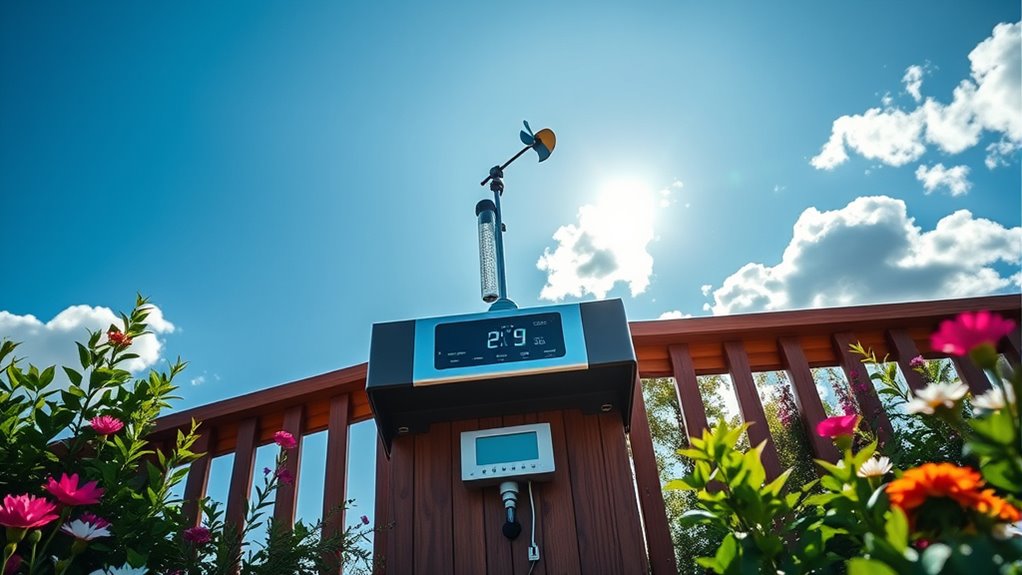
After preparing your site for installation, it's time to set up your weather station.
Choose a location that's open and level, steering clear of buildings or tall structures that could interfere with readings. Avoid reflective surfaces like asphalt, and make sure you have easy access for maintenance. Creating a calm environment is essential for focusing on your weather data collection, as this will enhance the accuracy of your emergency preparedness essentials. For instance, understanding local foraging practices can help you appreciate the natural environment around your weather station. Additionally, using a portable solar panel can provide a sustainable power source for your station, ensuring it operates efficiently in various conditions.
Use the provided mounting brackets or a sturdy pole to secure your station at a height of 6 to 8 feet for accurate wind measurements. Stability is crucial, so ensure it's firmly mounted to prevent sway.
Lastly, follow the manufacturer's instructions for connecting the power supply, whether you opt for batteries, solar panels, or electrical connections. Additionally, ensure that your setup complies with local fire safety regulations to maintain a safe environment for operation.
Your weather station is now ready for its final setup!
Configuring and Calibrating
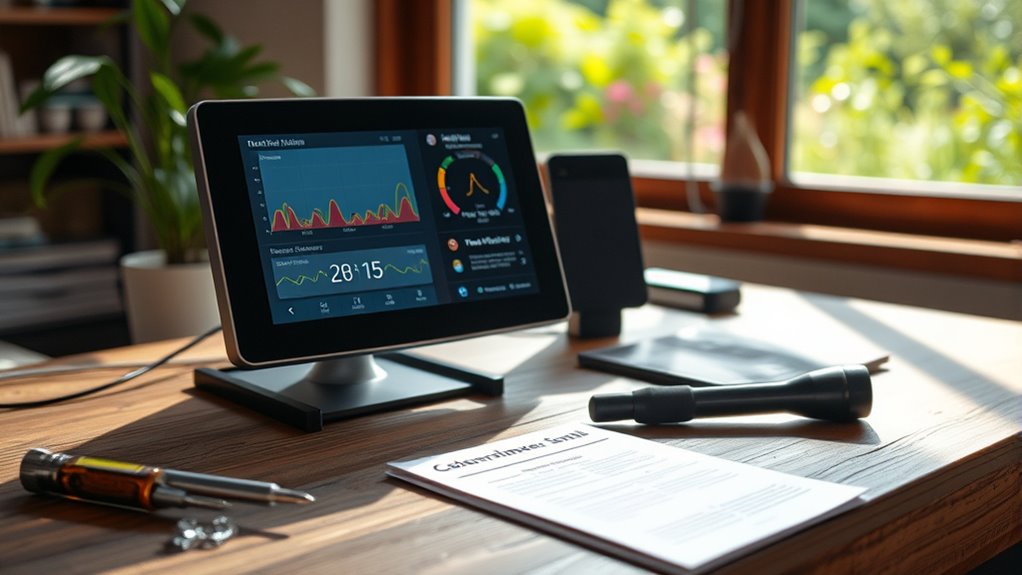
Configuring and calibrating your weather station is crucial for accurate readings and reliable data collection. Start by setting up the base unit indoors, ensuring it's within wireless range of all sensors. Connect it to a power source for stable operation, and configure the Wi-Fi settings for real-time data streaming.
Don't forget to set the data logger to record continuously. For calibration, zero out sensors upon installation and compare readings with trusted reference sources. Regular checks are essential, especially during weather changes. Heat pumps can behave similarly in terms of the necessity for regular maintenance to ensure optimal performance. Additionally, monitoring astrological influences can help determine the best days for calibration based on weather patterns. Regular maintenance can enhance system efficiency by up to 70% efficiency during calibration processes. Utilizing HEPA filters in air purifiers can also contribute to a healthier indoor environment, which is beneficial for accurate weather station readings.
Calibrate temperature sensors with a stable thermometer and humidity sensors with a calibrated hygrometer. Additionally, consider how humidity control features can improve overall data accuracy during calibration. Follow manufacturer guidelines for advanced sensors like UV and air quality sensors to ensure precision in your data collection.
Maintaining Your Weather Station
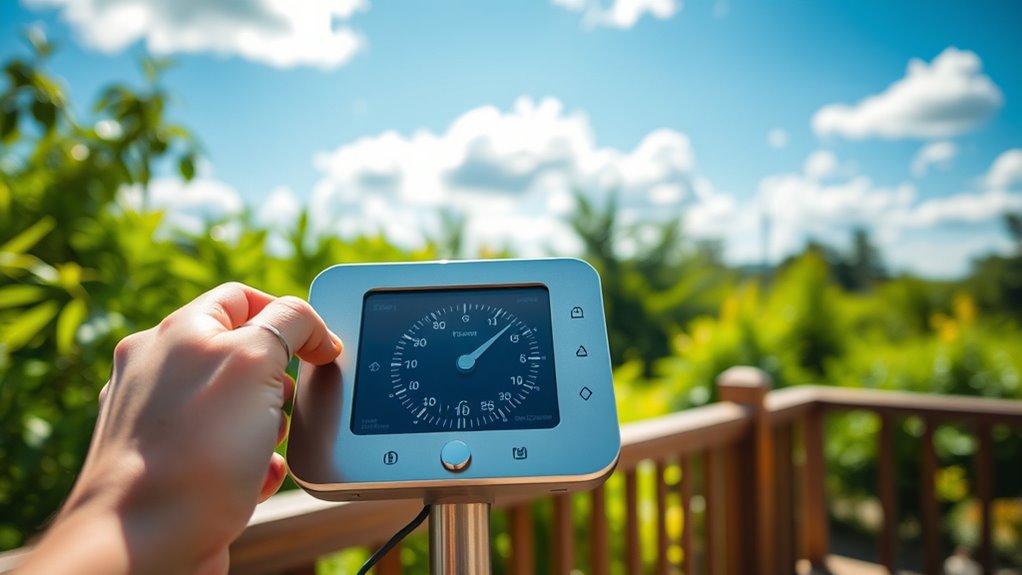
Maintaining your weather station is essential for ensuring accurate data and optimal performance. Regularly inspect sensors for damage or debris, and check that they're securely attached. It's also beneficial to understand the importance of regular maintenance to enhance the longevity of your equipment. Additionally, keeping a close eye on assisted living expenses can help in budgeting for any future upgrades or replacements needed for your station. Ensuring proper airflow around the unit is vital for optimal sensor performance. Moreover, creating a comfortable and functional environment can significantly improve the overall experience for seniors, which is a key aspect of senior living.
Verify the stability of mounting structures and ensure your power systems, like solar panels and batteries, are functioning correctly. Clean surfaces and internal components to promote airflow, and keep solar panels and rain gauges free of blockages.
Don't forget to replace batteries periodically to prevent data loss. Protect your equipment from extreme weather and ensure sensors are shielded from direct sunlight. Regular cleaning is essential for optimal performance of your weather station components.
Keep detailed maintenance records and monitor sensor performance. Engaging with weather communities can provide helpful tips, and don't hesitate to contact manufacturers for complex issues.
Data Analysis and Utilization
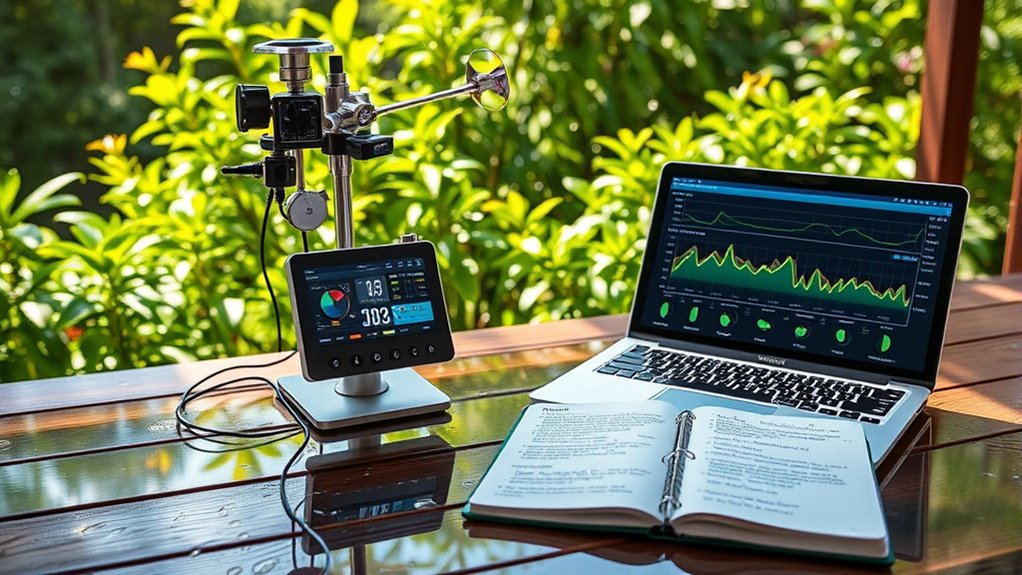
Data analysis and utilization form the backbone of effective home weather stations, enabling you to make sense of the data collected. By tracking temperature, humidity, wind speed, and precipitation, you can identify seasonal trends and local climate patterns. Techniques like time series and trend analysis help you spot patterns over time and predict future weather conditions. Correlation analysis reveals relationships between variables, while predictive modeling uses algorithms for accurate forecasts. Additionally, applying predictive analytics can enhance your ability to forecast weather conditions more accurately. Integrating AI tools for real-time performance tracking can further refine your weather data interpretation. Moreover, leveraging machine learning algorithms can improve your data analysis capabilities by identifying complex patterns that may not be immediately apparent. Given the ongoing climate change policies being discussed globally, understanding local weather patterns has never been more crucial. Furthermore, utilizing NLP technology can help automate the analysis of weather data, making it easier to derive insights quickly and effectively.
Utilizing this data benefits weather forecasting, agricultural management, and outdoor planning. Integrating with platforms like Weather Underground allows you to share your findings, enhancing community engagement. Ultimately, effective data analysis empowers you to make informed decisions tailored to your environment.
Tips for Enhancing Accuracy and Performance

Effective data analysis sets the stage for maximizing the performance of your home weather station.
Start by improving sensor accuracy; shield thermometers from direct sunlight and lubricate anemometer bearings regularly. Use larger funnels for rain gauges and ensure all sensors are calibrated and clean.
Optimize sensor placement by mounting anemometers at least 10 feet above obstructions, and place thermometers in shaded areas. Keep barometers sheltered and rain gauges level, away from trees or eaves.
Enhance reliability by waterproofing electronics and applying UV-resistant coatings. Ensure easy access for routine maintenance.
Boost wireless connectivity by extending antenna wires and relocating receivers away from obstacles. Regularly calibrate your equipment and document the process to maintain accuracy and functionality over time.
Frequently Asked Questions
What Are the Best Brands for Home Weather Stations?
When you're looking for the best brands for home weather stations, consider AcuRite for accuracy and user-friendly designs.
Ambient Weather offers great Wi-Fi connectivity, while Davis Instruments is perfect for professional-grade features.
La Crosse Technology provides affordable options for basic needs.
If you want innovative tech, check out WeatherFlow.
For intermediate choices, look at Ecowitt and Netatmo for smart home integration.
Each brand has unique strengths to fit your weather monitoring needs.
How Do I Connect My Weather Station to a Smartphone App?
Connecting your weather station to a smartphone app is like unlocking a treasure chest of data.
First, download a compatible app from your device's store. Once that's done, connect your weather station to your home Wi-Fi network—think of it as giving it a new address.
Then, follow the app's prompts to pair your sensors. Voila! You're now set to monitor real-time conditions right from your pocket.
Enjoy your weather adventure!
Can I Use a Weather Station Indoors?
Yes, you can definitely use a weather station indoors! Indoor weather stations measure temperature and humidity, helping you maintain a comfortable environment.
They often display current conditions and forecasts, so you're always informed. Just place the sensors strategically for optimal data collection, and ensure your display has a power source.
Many options are available, from basic models to advanced systems that integrate with smart home devices, providing valuable insights for your indoor space.
What Is the Lifespan of a Typical Weather Station?
A typical weather station's lifespan can range from 5 to 20 years, depending on its quality and the environmental conditions it faces.
If you've got a high-quality model in a mild climate, it might last over a decade. Regular maintenance, like cleaning and battery replacement, helps you extend its lifespan.
Keep in mind that harsh weather can significantly shorten its life, especially if you're near the coast or in extreme conditions.
Are There Any Legal Considerations for Personal Weather Stations?
Imagine you set up a personal weather station and your neighbor claims it obstructs their view.
Legal considerations for personal weather stations include checking local building codes and obtaining necessary permits. You should also consider environmental impacts and neighbor agreements.
Regular maintenance is vital to ensure data accuracy, as incorrect readings could lead to liability issues.
Lastly, be mindful of any homeowners' association rules that may apply to your installation.
Conclusion
Setting up your home weather station can be a rewarding project that deepens your understanding of local weather patterns. By choosing the right equipment and properly installing and calibrating it, you can enjoy accurate data at your fingertips. Don't forget to maintain your station for optimal performance! So, are you ready to take control of your weather experience and become your own meteorologist? With a little effort, you'll be amazed at the insights you can gain!
